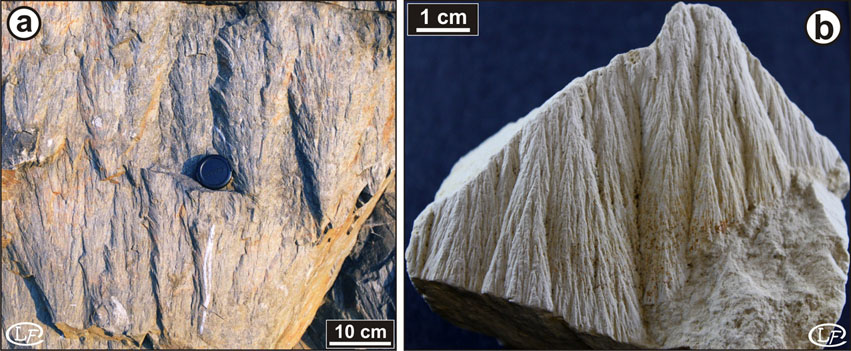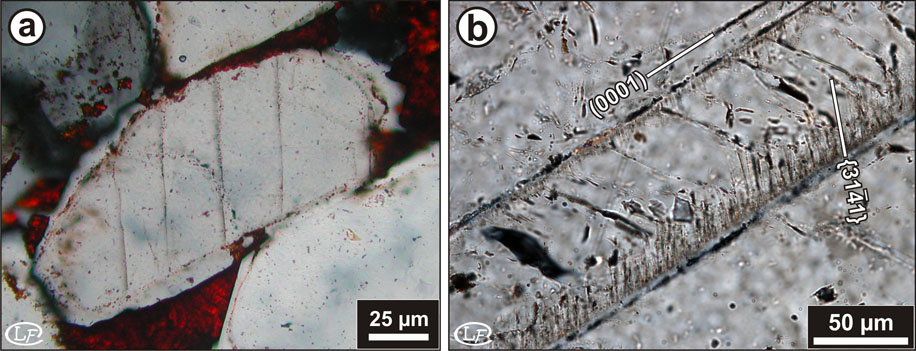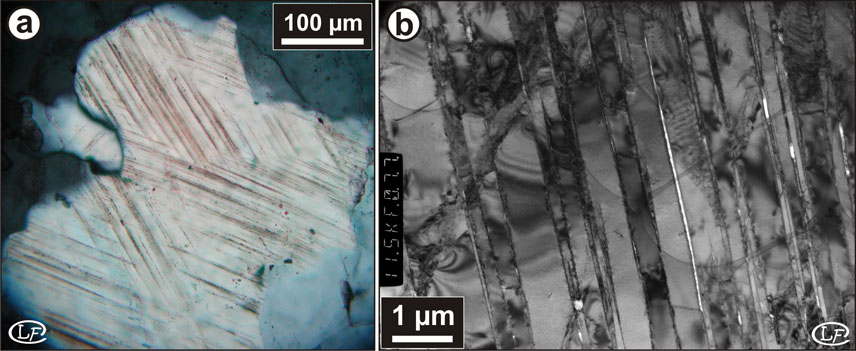The confirmation of a new meteorite impact structure needs to be supported by the presence of shock metamorphic indicators, either megascopic (e.g., shatter cones) or microscopic (e.g., planar deformation features in minerals), or by the presence of high-pressure polymorphs (e.g., coesite and stishovite) and/or siderophile element (e.g., iridium) or isotopic anomalies (e.g., in osmium) in specific geological settings. The terms “shock effects” or “shock-metamorphic effects” cover all types of shock-induced changes, such as the formation of planar microstructures and phase transformations. Impact metamorphism is essentially the same as shock metamorphism except that it also encompasses the melting, decomposition, and vaporization of target rocks. These irreversible changes are produced when rocks are subjected to high shock pressures.
A great diversity of
shock effects in minerals are known and have been abundantly
described, mostly for quartz (see, e.g., French and Short, 1968;
Stöffler and Langenhorst, 1994; Grieve et al., 1996; French, 1998;
and references therein), and to some extent for feldspar, olivine,
and pyroxene, mostly within meteorites. Less is known about the
shock effects in other minerals.
Shatter cones
Shatter cones are the only distinctive
shock-deformation feature that can be seen with the naked eye (e.g.,
Dietz, 1960, 1968). These meso- to macro-scale features, consisting
of conical striated fracture surfaces (see Figure 1), are best
developed in fine-grained lithologies (such as limestone), but can
also be observed in coarser-grained lithologies, such as granite, in
which, however, they are usually more poorly developed. By
definition, shatter cones are "distinctive curved, striated
fractures that typically form partial to complete cones" (French,
1998). The striated surface of shatter cones is either a positive or
a negative feature, with the striations radiating along the surface
of the cone. Shatter cones occur usually in the central uplifts of
complex impact structures and in some cases, isolated
fragments/clasts of shatter cones have been found in impact
breccias, within or outside the crater. They are generally found as
composite groups of commonly partial to complete cones, with very
frequently opposite orientations at the centimeter to decimeter
scale. Thus, the use of shatter cone apex orientation to determine
the centre of a crater and then its size is likely to yield
incorrect results.
| Navigation
Impact Cratering
Types of Impact Craters
Cratering Mechanics
Terrestrial Impactites
Impact Metamorphism |

|
|
| The formation of shatter cones, widely
accepted as unequivocal proof of a meteorite impact crater, is still
not completely resolved; It is generally accepted that shatter cones
form at relatively low shock pressures, typically between
approximately 2 and 10 GPa (e.g., French, 1998).
Deformation in quartz grains
1. Planar fractures (PFs)
Planar fractures are parallel, thin open fissures, generally greater than 3 µm wide and spaced more than 15–20 µm apart (see Figure 2a). The PFs are oriented parallel to rational crystallographic planes, such as (0001) and {10-11}, and occasionally to {10-13}.
PFs commonly control and/or limit the distribution of adjacent PDF sets, which has been used to suggest that PF formation predates PDF formation in a given quartz crystal grain (e.g., Engelhardt and Bertsch, 1969; Stöffler and Langenhorst, 1994). Formed at pressures of ~5–8 GPa, PFs are not regarded as unambiguous evidence of shock metamorphism, as they also occur, rarely, in quartz grains from non-impact settings (e.g., French, 1998).
2. Feather features
The so-called "feather features" are thinly spaced, short, parallel to subparallel lamellae (Poelchau and Kenkmann, 2010) or incipient PDFs (French et al., 2004) that branch off of PFs (Figures 2b). According to Poelchau and Kenkmann (2010), this type of planar microstructure are crystallographically controlled to a certain degree; These authors also suggest that they are caused by shearing of planar fractures. |

|
|
3. Planar deformation features (PDFs)
Planar deformation features in quartz grains, which develop over the pressure range of 5–10 to ~35 GPa (see Stöffler and Langenhorst, 1994; French, 1998; and references therein), are one of the best criterion for the identification of new impact structures. PDFs are typically composed of narrow, individual planes of amorphous material that are less than 2 µm thick, comprising straight, parallel sets spaced 2–10 µm apart (e.g., Engelhardt and Bertsch, 1969; Stöffler and Langenhorst, 1994). Generally occurring as multiple sets per grain, and typically in more than one crystallographic orientation, PDFs can be either decorated (with tiny fluid inclusions) or non-decorated (Figure 3). As PFs, PDFs are preferentially oriented parallel to rational crystallographic planes. The measurement of PDF orientations is possible using transmission electron microscopy (TEM) (e.g., Goltrant et al., 1991), as well as with the spindle stage (e.g., Bohor et al., 1987), or using the universal stage technique (e.g., Ferrière et al., 2009); such type of measurements allows to derive average shock pressure values for the investigated samples.
|

|
|
|
4. Mosaicism
Mosaicism is characterized by an irregular or mottled optical extinction pattern, which is distinctly different from undulatory extinction. A crystal showing mosaicism comprises several sub-domains with slightly different optical axes as a result of the distortion of the lattice into small domains that are rotated by low angles against each other. Even mosaicism is definitely induced by shock during impact event, somewhat resembling mosaic structure can be also produced by endogenic processes (see e.g., Spry, 1969), thus, it cannot be used as a unique diagnostic indicator of shock metamorphism.
Deformation in other minerals
Shock-induced deformation in other minerals that quartz are mainly of two types; namely planar microstructures (i.e., PFs and PDFs) and deformation bands (i.e., kink bands and mechanical twins).
With increasing shock pressure, feldspar grains develop fracturing, plastic deformation, PFs, or more frequently PDFs. PDFs have also been observed in olivine, pyroxene, amphibole, sillimanite, garnet, and apatite (see, e.g, Stöffler, 1972; French, 1998; Langenhorst, 2002; and references therein). Shock-induced deformation in zircon grains include mainly planar microdeformation features, such as pervasive micro-cleavage and dislocation patterns (see Leroux et al., 1999), and granular (or “strawberry”) textures (e.g., Bohor et al., 1993; Wittmann et al., 2006).
Kink bands are frequently observed in mica (e.g., Cummings, 1965; Hörz, 1970), but also in other minerals, mainly in sheet silicates. As kink bands are also observed in minerals from non-impact settings – such as in tectonically deformed rocks – they cannot be used as a diagnostic criterion for the impact origin of a structure.
Mechanical twins have been observed in a variety of minerals including pyroxene, amphibole, calcite, titanite, and ilmenite, and more rarely in plagioclase. These twins appear as sets of parallel bands, submicroscopic to some 10 µm in width (Stöffler, 1972).
Diaplectic glasses
Diaplectic glass forms without melting by solid-state transformation (De Carli and Jamieson, 1959), generally from framework minerals, such as quartz or feldspar. A fundamental diagnostic feature of diaplectic glass is that although it is amorphous, the pre-shock morphology and texture of the mineral are preserved and flow structures or vesicles are absent (e.g., Stöffler and Langenhorst, 1994). Two types of diaplectic glasses are frequently reported in the literature, namely, diaplectic quartz glass and maskelynite (i.e., diaplectic plagioclase feldspar glass; Tschermak, 1872; Bunch et al., 1967). Diaplectic glass starts to form at shock pressures higher than ~35 GPa for quartz in the case of dense non-porous crystalline rocks (e.g., Stöffler, 1972; Stöffler and Langenhorst, 1994; and references therein). However, in sandstones, diaplectic quartz glass starts to form at pressures as low as ~5.5 GPa (Kieffer et al., 1976).
Mineral and whole-rock melt
Melting of individual minerals starts at around 50 GPa (Stöffler, 1972) and at around 60 GPa for the whole-rock in the case of non-porous crystalline rocks, while for sandstones, melting of individual quartz grains starts at pressures as low as ~20 GPa and whole-rock melting occurs above ~30–35 GPa (Kieffer et al., 1976). Commonly observed in impactites, lechatelierite is a SiO2 melt that forms at very high temperatures (above 1700 °C) without necessarily requiring high shock pressures. Lechatelierite occurs in nature only in fulgurites and in impactites (e.g., Stöffler and Langenhorst, 1994; and references therein).
High-pressure polymorphs
High-pressure phases are commonly reported in impactites, for example, coesite and stishovite (from quartz), diamond (from graphite), and reidite (from zircon). However, coesite and diamond, are not exclusively formed during shock metamorphism as they are also products of endogenic processes (Schreyer, 1995). Other high-pressure polymorphs, such as jadeite (from plagioclase), majorite (from pyroxene), and wadsleyite and ringwoodite (from olivine) are commonly reported in meteorites (e.g., Ohtani et al., 2004; Fritz and Greshake, 2009; and references therein) – where they are interpreted as products of shock – but these phases have not yet been documented in terrestrial impactites. In addition, two rutile high-pressure phases, namely TiO2-II and akaogiite (El Goresy et al., 2001, 2010), were characterized notably in impactites from the Ries structure (Germany). Click here to view references. |
|